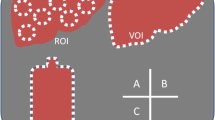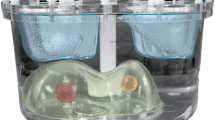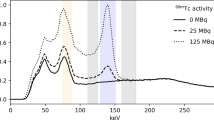Abstract
A new method for quantitative liver study was developed using the tracer technetium-99m diethylene triamine penta-acetic acid-galactosyl human serum albumin (99mTc-GSA), an analog ligand of the asialoglycoprotein receptor, which is a hepatocyte surface receptor specific for galactose-terminated glycoproteins. For quantitative dynamic single-photon emission tomographic (SPET) studies, attenuation compensation using transmission computed tomography (TCT) and the triple energy window (TEW) scatter compensation method were evaluated. As the TCT source, we used an uncollimated multi-tube source with the TEW scatter compensation method. To verify the accuracy of cross-calibrated SPET values as compared with measured radioactivities, we performed SPET of a cylindrical water pool phantom which contains seven hot rods filled with different concentrations of99mTc activities, simulating the scan conditions in human studies. The results of the phantom studies showed good linearity and accuracy of the SPET values, withR 2=0.993 and a regression line ofy=0.941x+5.48. From the analysis of a kinetic model based on a one-compartment model, focussing on the initial stage of several minutes after99mTc-GSA injection and taking the physiological expression presented in a three-compartment analysis into account, we introduced the Rutland equation (Patlak plot) in the99mTc-GSA study by which the overall and regional effective hepatic blood flow (EHBF) and hepatic blood pool volume were determined. Preliminary clinical evaluations were performed for four normal male subjects (23–35 years of age) and one patient. Forty sequential 30-s dynamic SPET acquisitions were obtained for a period of 20 min following the intravenous injection of99mTc-GSA with venous blood sampling at 10 min. After scatter compensation, the SPET images were reconstructed with attenuation compensation using an attenuation map obtained from TCT. The average normal value for the total EHBF was 468±83 ml/min and that for the hepatic blood pool volume, 777±123 ml. Functional images of the distribution of regional values of EHBF (ml/min/voxel) and hepatic blood pool volume (ml/voxel) were also generated corresponding to the original SPET images. The EHBF images showed regional liver function, higher in the right lobe than the left lobe in the normal cases, and the heptic blood pool volume images showed the distribution of intensified high values along major vascular structures. Receptor imaging with99mTc-GSA using the Rutland method and dynamic SPET with scatter and attenuation compensation is an effective technique that allows the evaluation of total and regional hepatic functional parameters (EHBF, hepatic blood pool) in vivo.
Similar content being viewed by others
References
Ogawa K, Takagi Y, Kubo A, Hashimoto S, Sannmiya T, Okano Y, Morozumi T, Nakajima M, Yuta S. An attenuation correction method of single photon emission computed tomography using gamma ray transmission CT.Jpn J Nucl Med 1985; 22: 477–490.
Ogawa K, Kubo A, Hashimoto S, Morozumi T, Nakajima M, Yuta S, Nogami S, Suzuki K. An attenuation correction of SPECT image using transmission data acquired with dual head gamma camera system.Med Imaging Technol 1985; 3S: 103–104.
Malko JA, Heertum RLV, Gullberg GT, Kowalsky WP. SPECT liver imaging using an iterative attenuation correction algorithm and an external flood source.J Nucl Med 1986; 27: 701–705.
Bailey DL, Hutton BF, Walker PJ. Improved SPECT using simultaneous emission and transmission tomography.J Nucl Med 1987; 28: 844–851.
Fery EC, Tsui BMW, Perry R. Simultaneous acquisition of emission and transmission data for improved thallium-201 cardiac SPECT using a technetium-99m transmission source.J Nucl Med 1992; 33: 2238–2245.
Jaszczak RJ, Gilland DR, Jang S, Gree KL, Coleman RE. Fast transmission CT for determining attenuation maps using a collimated line source, ratable air-copper lead attenuators and fan-beam collimation.J Nucl Med 1993; 34: 1577–1586.
Tan P, Bailey DL, Meikle SR, Eberl S, Fulton RR, Hutton BF. A scanning line source for simultaneous emission and transmission measurements in SPECT.J Nucl Med 1993; 34: 1752–1760.
Ichihara T, Ogawa K, Motomura N, Kubo A, Hashimoto S. Compton-scatter compensation using the triple energy window method for single and dual isotope SPECT.J Nucl Med 1993; 34: 2216–2221.
Ichihara T, Motomura N, Hasegawa H, Ogawa K, Hashimoto J, Kubo A. Improved transmission tomography using flood source and TEW scatter correction for attenuation compensation.J Nucl Med 1995; 36: 166.
Hashimoto J, Sammiya T, Ogasawara K, Kubo A, Ogawa K, Ichihara T, Motomura N, Hasegawa H. Scatter and attenuation correction for quantitative myocardial SPECT using transmission measurement with a sheet line source.Jpn J Nucl Med 1996; 33: 1015–1019.
Torizuka K, Kawa SKH, Kudo M et al. Phase III multi-center clinical study on Tc-99m GSA, a new agent for functional imaging of the liver.Jpn J Nucl Med 1992; 29: 159–181.
Vera DR, Stadalnik RC, Trudeau WL, Scheibe PO, Krohn KA. Measurement of receptor concentration and forwardbinding rate constant via radiopharmacokinetic modeling of technetium-99m-galactosyl-neoglycoalbumin.J Nucl Med 1991; 32: 1169–1176.
Kudo M, Todo A, Ikekubo K, Hino M, Yonekura Y, Yamamoto K, Torizka K. Functional hepatic imaging with receptorbinding radiopharmaceutical: clinical potential as a measure of functioning hepatocyte mass.Gastroenterol Jpn 1991; 26: 734–741.
Kawa SHK, Tanaka Y. A quantitative model of technetium-99m-DTPA-galactosyl-HSA for assessment of hepatic blood flow and hepatic binding protein.J Nucl Med 1991; 32: 2233–2240.
Shuke N, Aburano T, Nakajima K et al. The utility of quantitative 99mTc-GSA liver scintigraphy in the evaluation of hepatic functional reserve: comparison with99mTc-PMT and99mTc-Sn colloid.Jpn J Nucl Med 1991; 29: 573–584.
Rutland MD. A single injection technique for subtraction of blood background in I-131-hippuran renograms.Br J Radiol 1979; 52: 134–137.
Patlak CS, Blasberg RG, Fenstermacher JD. Graphical evaluation of blood-to-brain transfer constants from multiple-time uptake data.J Cereb Blood Flow Metab 1983; 3: 1–7.
Gilland DR, Jaszczak RJ, Jang S, Greer KL, Coleman RE. Quantitative SPECT reconstruction of iodine-123 data.J Nucl Med 1991; 32: 527–533.
Iwasa M, Nakamura K, Nakagawa T, Watanabe S, Kato H, Kinosada Y, Maeda H, Habara J, Suzuki S. Single photon emission computed tomography to determine effective hepatic blood flow and intrahepatic shunting.Hepatology 1995; 21: 359–365.
Maeda H, Takeda K, Matsumura K, Nakagawa T, Kitano T, Ejiri K, Kondou T, Takeuti K, Toyama H, Takeshita G, Koga S, Ichihara T. The influence of the time activity variation on dynamic SPECT images in camera-based SPECT.Jpn J Nucl Med 1991; 28: 27–34.
Nakajima K, Shuke N, Taki J, Ichihara T, Motomura N, Bunko H, Bunko H, Hisada K. A simulation of dynamic SPECT using radiopharmaceuticals with rapid clearance.J Nucl Med 1992; 33: 1200–1206.
Very DR, Krohn KA, Stadalnik RC, Scheibe PO. [Tc-99m]galactosyl-neoglycoalbumin: in vitro characterization of receptor-mediated binding.J Nucl Med 1984; 25: 779–787.
Shinohara H, Niio Y, Hasebe S, Matsuoka S, Obuchi M, Suminori T, Yamada M, Takagi T, Takizawa K, Honda M, Kuniyasu Y. Quantitative analysis of99mTc-GSA liver scintigraphy with graphical plot method. Nippon Acta Radiol 1996; 56: 208–214.
Author information
Authors and Affiliations
Rights and permissions
About this article
Cite this article
Ichihara, T., Maeda, H., Yamakado, K. et al. Quantitative analysis of scatter- and attenuation-compensated dynamic single-photon emission tomography for functional hepatic imaging with a receptor-binding radiopharmaceutical. Eur J Nucl Med 24, 59–67 (1997). https://doi.org/10.1007/BF01728310
Received:
Revised:
Issue Date:
DOI: https://doi.org/10.1007/BF01728310




